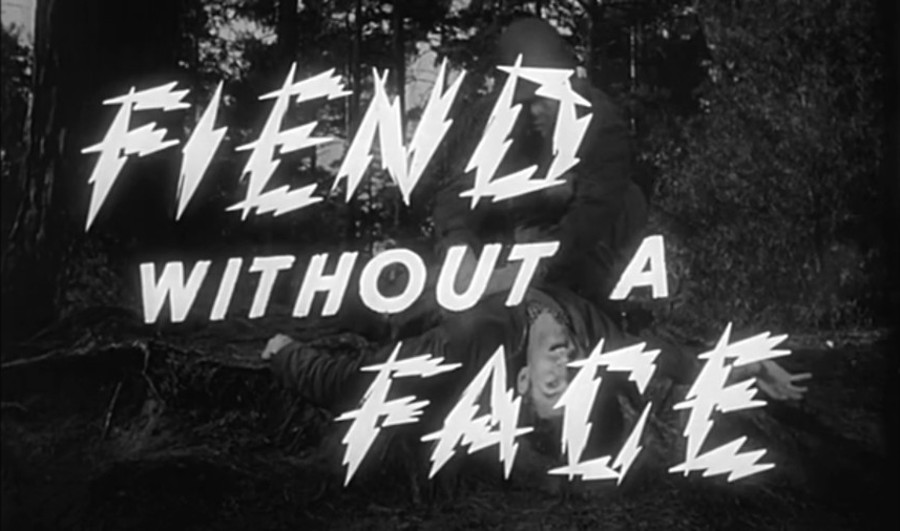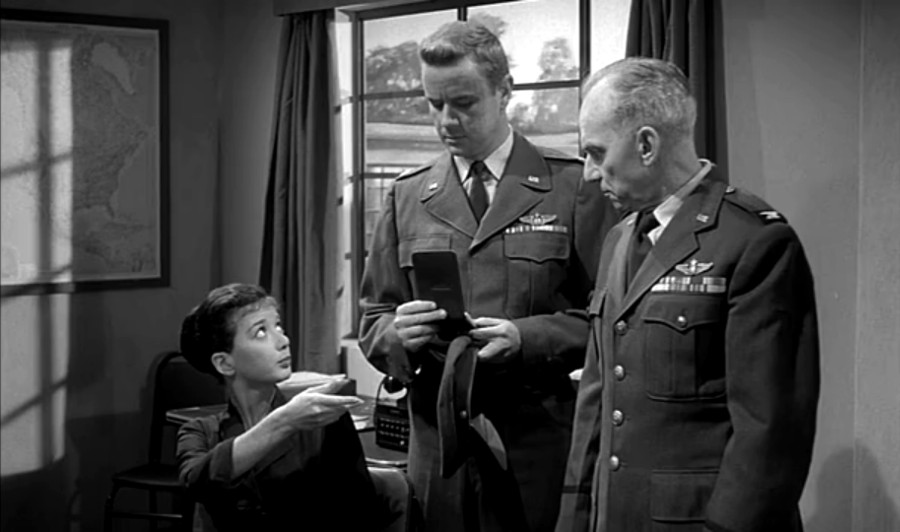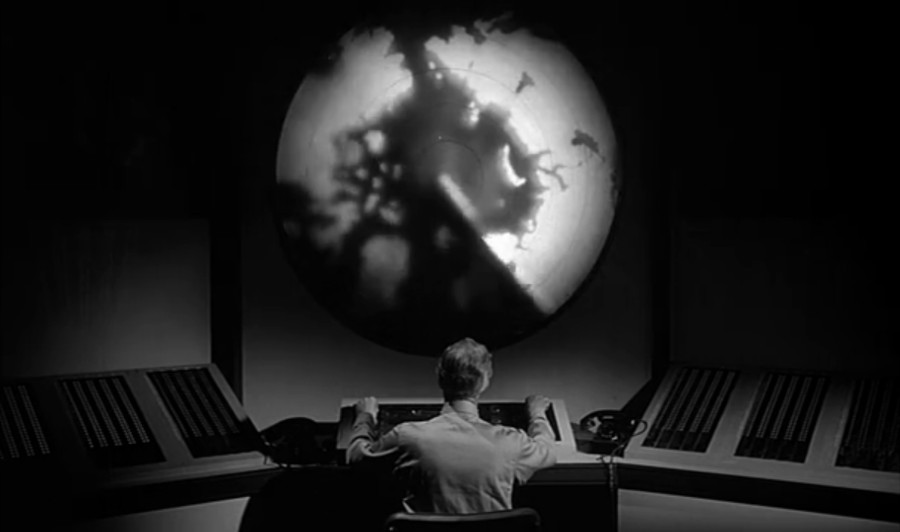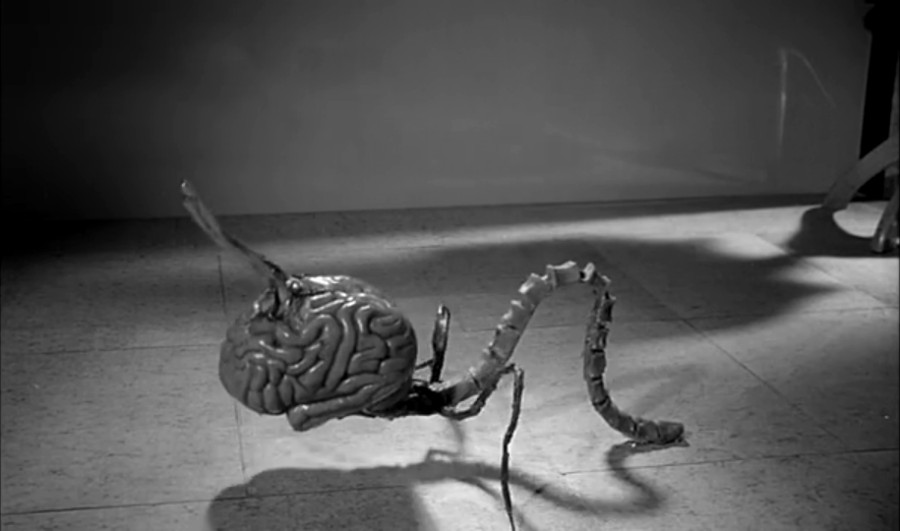Hey, we’re back with some more scary movies for Halloween. I actually started to recap this particular film last year, but ended up not finishing, so I held it over for this year. Today we’ll be featuring 1958’s Fiend Without a Face, directed by Arthur Crabtree for Amalgamated Productions. Like Amalgamated’s later First Man into Space, Fiend was filmed in England while ostensibly taking place in North America. And like First Man into Space, it stars Marshall Thompson as a military man facing off against alien horror.
The film opens at a U.S. Interceptor Command Experimental Air Station in Manitoba, Canada, apparently a Cold War DEW Line site. A guard patrolling outside the base hears mysterious noises and a scream. He runs to the sound to find a dead man on the ground. CREDITS!
Now we are introduced to Major Jeff Cummings (Thompson), who is wrestling with two problems simultaneously. One is a mysterious power fade that happens every time they fire up their big atomic-powered experimental radar (theoretically powerful enough to cover the entire Arctic region with one installation), and the other is the dead guy they just found snooping around outside the base, Jacques Griselle.
Griselle’s sister Barbara (Kim Parker) refuses to have an autopsy performed, which seems suspicious, since the dead man was carrying a notebook recording the base’s take-offs and landings. According to Barbara (and confirmed by the dead man’s notes), their cows were turning out bad milk, and Griselle was trying to get evidence that it was the jets flying overhead that caused it. Major Cummings drives Barbara home and they share an instant bond.
Later, they perform another test of their experimental radar, but within minutes, the power begins to fade on them. Cummings calls to the control room of the nuclear reactor and calls for more power. They have an argument over removing control rods (a nicely realistic touch), but even with the power boosted, the results are no better, almost as if the power were being drained off by something else. The experiment is called off and the planes ordered to return. Not long after, a farmer and his wife are killed by a mysterious invisible force. An autopsy on the farmer reveals his brain and spinal cord are missing, sucked out through two small holes at the base of the skull.
Major Cummings is ordered to interview the townspeople for unusual events. He takes the opportunity to beeline straight to Barbara Griselle’s place, where he catches her coming out of the shower so the movie can get in a little obligatory cheesecake for the one-sheet.
While she gets dressed, he finds a manuscript titled “The Principles of Thought Control” by R.E. Walgate. Barbara explains that she works for the retired professor, transcribing his tapes and compiling his notes. The major flirts with her until they are interrupted by town constable Howard Gibbons, who is suspicious of goings on at the base and jealously protective of Barbara. Cummings and Howard have a scuffle, which Barbara breaks up and sends the major on his way.
Cummings returns to the base and begins to research Professor Walgate. That night, the invisible creature breaks into the mayor of Winthrop’s house and kills him, which the next day sets off an angry mob patrolling the town with rifles searching for the murderer. Meanwhile, Major Cummings decides to pay a visit to Professor Walgate. Professor Walgate is a kindly old man who knows way more than he should about the atomic radar experiments at the base. As they talk, the professor has a dizzy spell, which prompts Barbara to ask Major Cummings to leave again. Romance is never easy.
As the search party approaches the air base, Howard Gibbons and friend hear the mysterious sounds of the invisible creature. Gibbons disappears. An emergency meeting called by the town council leads to angry accusations about the presence of the experimental air base. People are fearful of radiation and don’t trust the military men’s reassurances. Barbara speaks up in defense of the base, saying that it was the jet noise, not radiation, that has been affecting the milk output, and the cows are adjusting. The meeting is interrupted by the arrival of Gibbons, face disfigured and moaning like a mindless madman (apparently, though it is never explained, they only sucked out half his brain or something).
After the meeting, Cummings tells Barbara that he suspects Professor Walgate has something to do with the mysterious deaths. Cummings investigates the local cemetery. In the mayor’s burial crypt, he finds the coffin open and the Professor’s pipe sitting next to it. Someone closes the crypt door, locking him in. He is rescued by Barbara and a fellow officer just before the air in the crypt runs out. Cummings immediately asks to see Walgate.
Cummings confronts Walgate about his experiments in mind-over-matter and asks if it could be done with the help of atomic power. As the Professor is about to confess something, they hear the sounds of the invisible creature, and the Professor swoons. He manages to tell Cummings to shut down the atomic reactor.
Cummings convinces his commander to do so, but there’s a problem: the control rods necessary to shut down the atomic reaction have all been smashed. There is no way to shut the reactor down without them. They call for an emergency resupply from a base about 4 hours away.
And I know I’ve mentioned it before, but this is pretty awesome. Instead of simply invoking movie science and having some sort of on-off switch in the control room, someone did some actual research on atomic power and included the detail about the control rods, which are used to regulate the power output of a nuclear reactor. So bonus points for verisimilitude here, although they’ll get taken away soon enough. Just wait.
Professor Walgate has recovered and confesses that he knows what is going on. In flashback, he tells how he built a machine to “materialize” his thought waves and make them able to move objects. The machine used power from the atomic station to create invisible beings made of thought energy. But the Professor has since lost control of his creation. The creatures act independently now, drawing energy from the atomic plant (and causing the mysterious power fades) and eating people’s brains. As the professor finishes his confession, the house is surrounded by the creatures, which begin to break into the house.
Meanwhile, the personnel running the atomic plant are killed by the invisible creatures, and the power output increases into the danger zone. The power becomes so great that the creatures become visible, taking the form of brain-heads with spinal-column bodies and nerve tentacles. And antennae, for some reason.
And now we enter the big climax of the film, which is half-awesome and half-idiotic.
Professor Walgate insists that the only way to stop the creatures is to shut down the atomic plant (which, as we’ve learned earlier, can only be shut down with control rods that still haven’t arrived from the other base). But suddenly, Cummings volunteers to use dynamite to blow up the control room, which will shut down the unshutdownable reactor because plot. The logic here is the same as those movies where guys decide to destroy a computer by shooting the monitor. It wouldn’t actually work, but it looks cool and seriously, we need to start wrapping up this story, guys, so don’t start nitpicking now.
Anyway, Walgate goes out with him in the hope of controlling some of the creatures, but is immediately attacked and killed. The rest of the film cuts back and forth as Cummings fights to get the dynamite set up in the control room while the people back at Walgate’s farmhouse–Barbara, the commander, and a couple of others–fight a desperate battle to survive an onslaught of stop-motion brain creatures, in a brief, but genuinely exciting sequence. Just as Barbara is about to get her brain sucked out, the dynamite explodes and the creatures all melt into disgusting slimy puddles. Cummings and Barbara are reunited and kiss as we fade out.
All in all, it’s not bad, as low-budget 50’s sci-fi goes. A little fan-service here, some creepy stop-motion creatures there, and even a little actual research stuck in there. The film is part of the Criterion Collection and can be viewed on Hulu Plus, if you’re curious.








